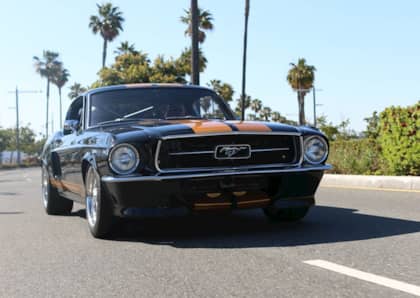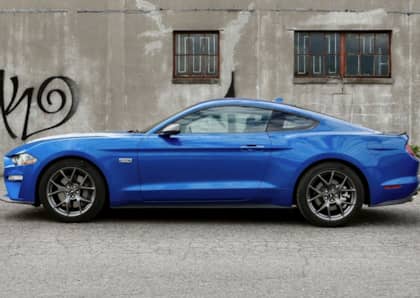1989-1997 Ford Thunderbird Offers Undercover V8 Performance And Supercharged Fun
The Ford Thunderbird lead many different lives during its nearly 50 years of production. What started off as a garage-friendly roadster ended its days in a similar fashion, with the final convertible model aping the original's styling (and polarizing FoMoCo fans with its retro design).
In between, despite flirtations with a four-door model in the late-1960s the Thunderbird primarily served as a personal luxury coupe with sporting pretensions. By the end of the 1980s this template reached its apex with the MN12 generation of the car, a model that shed the Fox platform roots that had defined it for much of the decade in favor of a new, sophisticated chassis that delivered a choice between supercharged V6 or large-displacement V8 power.

Despite the 1989-1997 Ford Thunderbird's muscle car bonafides, it's largely been passed over by collectors and even Rad era aficionados in favor of import grand tourers (the BMW 6 Series, the Mercedes-Benz 560 SEC) and more common street machines (Chevrolet Camaro, Ford Mustang). The Thunderbird's under-the-radar status is a bonus for anyone who's seeking a stealthy, budget-friendly cruiser with legitimate sports car potential when properly customized.
Heavy Metal Thunder
Classic car collectors aren't the only ones entranced by Euro-sourced, big-boned coupes. It turns out that Ford's designers were also looking across the Atlantic when considering how to evolve the Thunderbird from sharing its humble underpinnings with the Mustang. Specifically, the BMW 6 Series gave the Blue Oval a lot to think about in terms of drivetrain layout, suspension details, and aerodynamics.

Ford already had a lock on the latter, as its Aero Bird had made major waves in NASCAR thanks to luminaries like Georgia-based driver Bill Elliot who won a championship in 1988 behind the wheel of the previous T-Bird. The decision to stick with a rear-wheel drive setup, however, bucked not only Ford's internal momentum towards front-wheel drive (the successful Taurus, the upcoming Probe and Lincoln Continental), but the general feeling in Detroit as both General Motors and Chrysler increasingly embraced the technology to reduce costs and improve fuel efficiency.

What came to be known as the MN12 platform instead installed the Thunderbird's first independent suspension out back (a nod to the 6 Series) and preserve the purer handling dynamics of rear-wheel drive. This was a big deal, as only the Corvette could boast the same sophisticated combo through the corners while wrapping itself in the American flag.

That's not to say that there weren't a few concessions towards cost cutting. The car borrowed hubs from the Taurus, which meant smaller brakes than would normally be prudent on a two-ton automobile, and rather than design the vehicle so that it could feature both six and eight-cylinder engine choices it was instead form-fitted around a 140 horsepower version of the brand's familiar 3.8-liter V6. High trim levels got an Eaton supercharged version of this motor (in the Super Coupe) that was good for 210 horsepower and 315 lb-ft of torque (which surpassed V8-level outputs of the time). It was good enough for a 7.5 second 0-60 time, keeping the Thunderbird competitive with other large coupes.

Another nod to the MN12 Thunderbird's European inspiration was the inclusion of adjustable Tokico shock absorbers that could automatically parse a rough road or be set to 'Firm' in order to provide the stiffest level of body control. This worked together with anti-lock brakes and a locking rear differential to help further refine the T-Bird's ride.
V8 Arrives…Eventually
With a longer wheelbase, but a shorter overall length than the Thunderbird it replaced, the MN12 was a comfortable cruiser that delivered better stability in the corners. The Super Coupe also offered a standard manual five-speed transmission (sourced from Mazda) alongside its available four-speed automatic, which gave enthusiasts the opportunity to wring out as much fun as possible from its admittedly heavy design. The coupe's heft became a sticking point for Ford brass irritated with the Thunderbird team's inability to bring the car in at its goal weight (being nearly 500 lbs heavier than the Fox-based T-Bird in certain configurations).

After three years of Thunderbird production the popular 5.0 V8 finally found its way under the car's plunging hood line, although the Super Coupe's V6 remained the top dog in terms of performance. With a 200 horsepower rating the eight-cylinder couldn't touch the SC (which eventually saw its output raised to 230 horses and 330 lb-ft of twist by 1994), and it was positioned as the mid-tier model. Still, customers seemed more keen on cylinder count than spec sheet details, and quickly made the more modestly-priced V8 the most popular option.

The writing was on the wall for both the 5.0 and the SC by 1994. The former was replaced by Ford's modular 4.6-liter V8 which arrived in the T-Bird before it did in the SN95 Mustang. It delivered 205 horsepower with greater efficiency than the pushrod design, and by the end of 1995 the supercharged motor had also been wiped off the books (with the Super Coupe's suspension upgrades living on in the form of the Sport Option). Two years later, the final MN12 Thunderbird rolled off the line, its popularity diminished by the SUV craze that would relegate personal luxury coupes to the scrap heap.
Cheap, Intriguing, Fun V8 Muscle
Today, the 1989-1997 Ford Thunderbird is easy to find and cheap to buy. Even if you don't include the 600,000 or so versions of the Mercury Cougar that shared its platform, there were 960,000 T-Birds built, which has created an oversupply for fans seeking a clean example.

The best parts about the car are its drivetrain, with the supercharged V6 and both V8s responding well to mods. Although the modular motor is more of an investment in terms of adding horsepower, it's a fully-modernized, OBD-II compliant design that by now has a strong aftermarket thanks to the Mustang.

Trouble spots on the MN12 include rotting sunroof drains, sagging doors, composite intake manifolds on later 4.6-liter cars, rocker panel and lower door rust, and suspension joints and links. Avoid corroded cars, but don't despair about other issues as they are easy enough to address.

Most intriguing is just how stealthy these cars are on the performance scene. With big power only a modest infusion of cash away, it's not at all complicated to build a near-invisible highway missile that offers exceptional comfort and pleasing, understated styling. Dig a little deeper and the suspension can be upgraded, too, which allows the hefty T-Bird to dance with a little more precision than when it left the factory. Either way, this under-appreciated coupe is one of the few performance icons of the '80s and '90s to have escaped the attentions of the market at large.
More From Driving Line
- Curious about the history of turbocharged and supercharged T-Birds? We've got you covered with this deep dive into the history of the forced-induction Ford Thunderbird.











